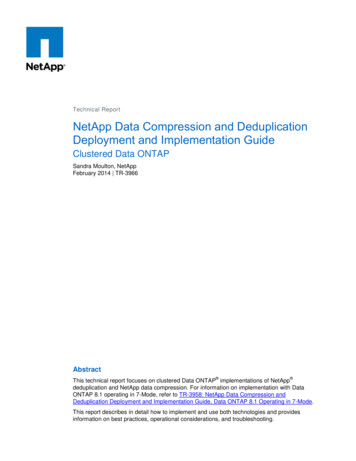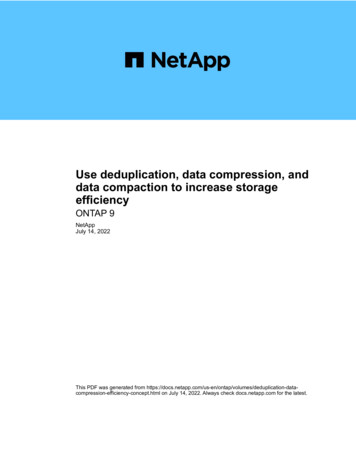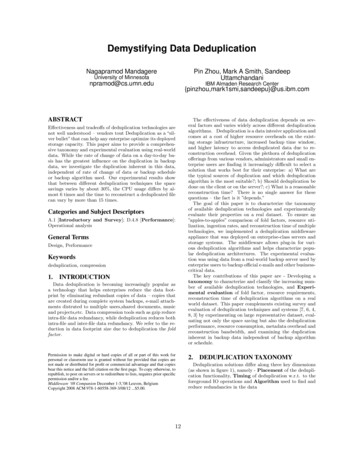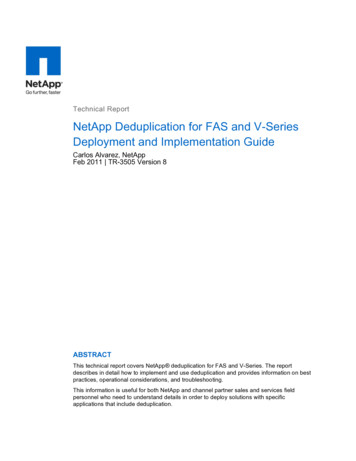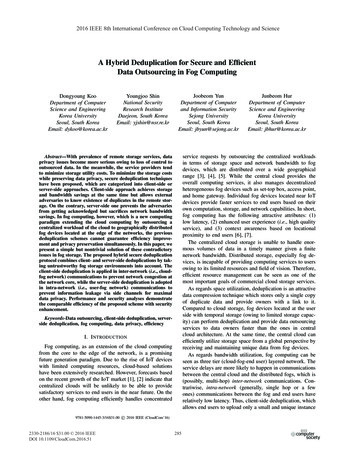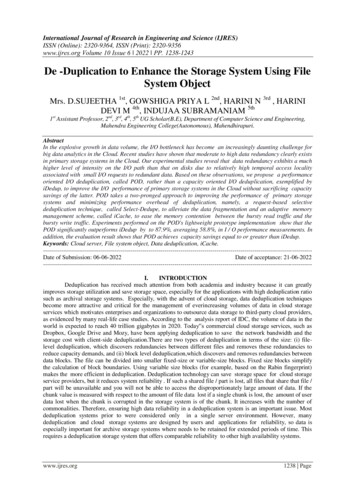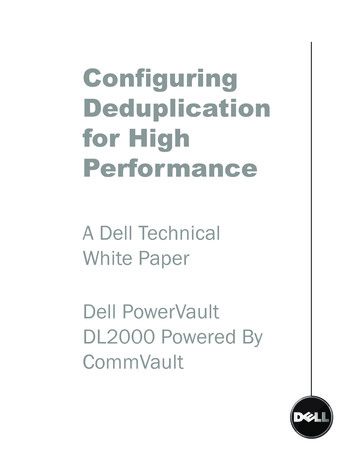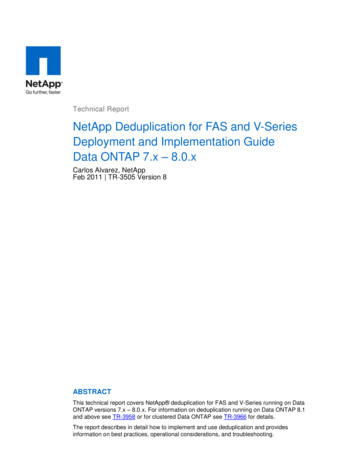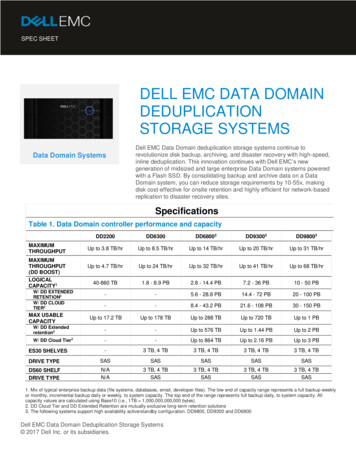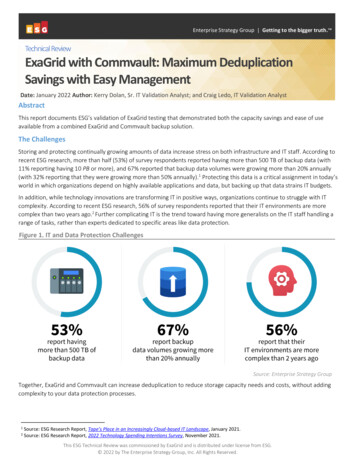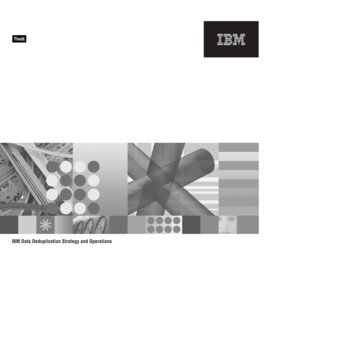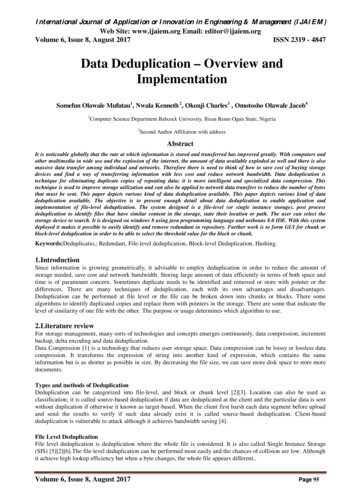
Transcription
International Journal of Application or Innovation in Engineering & Management (IJAIEM)Web Site: www.ijaiem.org Email: editor@ijaiem.orgVolume 6, Issue 8, August 2017ISSN 2319 - 4847Data Deduplication – Overview andImplementationSomefun Olawale Mufutau1, Nwala Kenneth 2, Okonji Charles3 , Omotosho Olawale Jacob41Computer Science Department Babcock University, Ilisan Remo Ogun State, Nigeria2Second Author Affiliation with addressAbstractIt is noticeable globally that the rate at which information is stored and transferred has improved greatly. With computers andother multimedia in wide use and the explosion of the internet, the amount of data available exploded as well and there is alsomassive data transfer among individual and networks. Therefore there is need to think of how to save cost of buying storagedevices and find a way of transferring information with less cost and reduce network bandwidth. Data deduplication istechnique for eliminating duplicate copies of repeating data; it is more intelligent and specialized data compression. Thistechnique is used to improve storage utilization and can also be applied to network data transfers to reduce the number of bytesthat must be sent. This paper depicts various kind of data deduplication available. This paper depicts various kind of datadeduplication available. The objective is to present enough detail about data deduplication to enable application andimplementation of file-level deduplication. The system designed is a file-level (or single instance storage), post processdeduplication to identify files that have similar content in the storage, state their location or path. The user can select thestorage device to search. It is designed on windows 8 using java programming language and netbeans 8.0 IDE. With this systemdeployed it makes it possible to easily identify and remove redundant in repository. Further work is to form GUI for chunk orblock-level deduplication in order to be able to select the threshold value for the block or chunk.Keywords:Deduplicatio,; Redundant, File-level deduplication, Block-level Deduplication, Hashing.1.IntroductionSince information is growing geometrically, it advisable to employ deduplication in order to reduce the amount ofstorage needed, save cost and network bandwidth. Storing large amount of data efficiently in terms of both space andtime is of paramount concern. Sometimes duplicate needs to be identified and removed or store with pointer or thedifferences. There are many techniques of deduplication, each with its own advantages and disadvantages.Deduplication can be performed at file level or the file can be broken down into chunks or blocks. There somealgorithms to identify duplicated copies and replace them with pointers in the storage. There are some that indicate thelevel of similarity of one file with the other. The purpose or usage determines which algorithm to use.2.Literature reviewFor storage management, many sorts of technologies and concepts emerges continuously, data compression, incrementbackup, delta encoding and data deduplication.Data Compression [1] is a technology that reduces user storage space. Data compression can be loissy or lossless datacompression. It transforms the expression of string into another kind of expression, which contains the sameinformation but is as shorter as possible in size. By decreasing the file size, we can save more disk space to store moredocuments.Types and methods of DeduplicationDeduplication can be categorized into file-level, and block or chunk level [2][3]. Location can also be used asclassification; it is called source-based deduplication if data are deduplicated at the client and the particular data is sentwithout duplication if otherwise it known as target-based. When the client first harsh each data segment before uploadand send the results to verify if such data already exist it is called source-based deduplication. Client-baseddeduplication is vulnerable to attack although it achieves bandwidth saving [4].File Level DeduplicationFile level deduplication is deduplication where the whole file is considered. It is also called Single Instance Storage(SIS) [5][2][6].The file-level deduplication can be performed most easily and the chances of collision are low. Althoughit achieve high lookup efficiency but when a byte changes, the whole file appears different.Volume 6, Issue 8, August 2017Page 95
International Journal of Application or Innovation in Engineering & Management (IJAIEM)Web Site: www.ijaiem.org Email: editor@ijaiem.orgVolume 6, Issue 8, August 2017ISSN 2319 - 4847Block or Chunk Level DeduplicationThis is when file is divided into chunks or blocks and the individual chunks or block is considered for deduplication bycomparing their fingerprints [7]. If the fingerprints which are hash values computed by hash function are found thesame with the one already in the repository, pointers are used to indicate the data chunk already in existence. Thematch frequency is dependent on the chunk size and the threshold used; the amount of data that must be stored ortransferred can be greatly reduced. Each chunk of data is assigned identification, calculated by the software, typicallyusing cryptographic hash functions. Block deduplication requires more processing power than the file deduplication,since the number of identifiers that need to be processed increases greatly [8]. The unit of data being process is a“chunk”. Chunk may be defined by physical layer constraint or by comparing the size of the entire file or by finding thepattern that occurs within internal file boundaries through sliding the reference window along the file stream. Chunksize is determined by suitable algorithm. Since each chunk is to be hashed individually, this type of deduplicationrequires more processing power and there is tendency of hash collision. Chunking can be fixed or variable [9][10][11].This is common to disk-based backup technology [8].Fixed-Length or Fixed BlockFile is broken into segment, or block or chunk of fixed length. Reference window of fixed size may be used to look forthe chunk. The block may be of the fixed size like 4KB, or 8KB, 32 etc [6][8].Variable-Length or Variable BlockFile is divided into variable length block or chunk. Variable length window is used for deduplication[6][8].Content Defined Chunking (CDC) algorithmIn Content Defined Chunking (CDC) algorithm [12] the incoming data stream is broken into chunks when the contentwindow before the breakpoint meet-up with condition stipulated. CDC algorithm is used to divide the data stream intochunks; fingerprint is computed by chunk fingerprinting (example, SHA-1 value) for each of the chunks. Fingerprintindexing and querying stores the fingerprints according to a certain data structure for indexing and queries the index tofind chunks of identical fingerprints. Data storing and management stores new chunks and representative referencepointers for the duplicated chunks. The sliding-window-based CDC algorithm [13] have been the dominating CDCalgorithms though is not optimal, especially in terms of deduplication performance, since it has to slide the contentwindow byte by byte.Two Threshold Two Divisor (TTTD)Another most frequently used variable-length chunking algorithm [14]. The TTTD chunking method ascertains thatchunks smaller than a particular size are not produced. But the chunks produced might escape duplicate detention aslarger chunks are more likely to be related than smaller ones. The method ignores the chunk boundaries after aminimum size is reached. TTTD applies two techniques where two divisors (D, the regular divisor and D0, the backupdivisor) are used. By applying these divisors, TTTD guarantees a minimum and maximum chunk size. A minimum anda maximum size limit is used for splitting a file into chunks for searching for duplicates.Byte-level deduplicationChunks are compared byte by byte and this makes it more accurate although it takes time [15][16].Post-process deduplicationTarget deduplicationData is stored on the storage device and then process at any time deemed fit for deduplication[17]In-line deduplicationDeduplication is done before data are stored in the storage device. Although it requires more computing power but itmanages space. Hash calculations are created on the target device as the data enters the device in real time. [18].This is when deduplication occurs near where the data is finally stored or transferred to.Network data deduplicationThis happen in the Network to reduce the number of bytes that must be transferred between nodes or terminals. Thiscan reduce the bandwidth and the throughput [19].Basic Sliding Window (BSW)BSW is used for marks the boundary of file and stipulate break condition logic. Chunk boundary is computed based onthe fingerprint algorithm. File boundary is marked based on break condition. The problem with this approach is thechunk size. The size of the chunk cannot be predicted with this approach. But it is possible to predict the probability ofVolume 6, Issue 8, August 2017Page 96
International Journal of Application or Innovation in Engineering & Management (IJAIEM)Web Site: www.ijaiem.org Email: editor@ijaiem.orgVolume 6, Issue 8, August 2017ISSN 2319 - 4847getting a larger chunk or a smaller one. This probability is defined based on the probability of getting a particularfingerprint[13].Hash based DeduplicationHashing is the method of producing unique check sum value or mathematical representation of specific chunk or blockof data. The value generated is then the fingerprint used to reference data in metadata when checking for similarity orduplication. There various algorithm with different reliability. Collision occurs when two or more chunks have thesame fingerprint or signature [17]. Hash based data de-duplication methods use a hashing algorithm to identify“chunks” of data. Commonly used algorithms are Secure Hash Algorithm 1 (SHA-1) and Message-Digest Algorithm 5(MD5) [20]. Using MD5, a fixed length output of 128 bits is produces when a variable length message is process. Acryptographic hash function is used for security of document [21].Evaluation of similarity measure for Text DocumentDegree of similarity between documents sentences needs to be considered and measure when discussing deduplication,document clustering and text summarization.Text similarity is partitioned into three approaches; String-based, Corpus-based and Knowledge-based similarities andalso categorized into lexical and semantic. Words with similar character sequence are lexically similar and isassociated with String-Based algorithms which considers the arrangement and the sequence of character in thedocument [22].Figure 1 (Wael H.G, Aly A. F,)String-Based SimilarityString similarity matching considers the composition, sequence and arrangement of the characters in document. Astring metric is a measure used for this consideration.Longest Common SubString (LCS): The length of similar sequence of characters is considered in two strings [22].Jaro Distance takes into account the arrangement and order of characters between two strings. It also considers thedifference in spelling [23][24].Edit or Levenshtein distance convert from one form of string to another by involving edit operations. Edit operationinvolve inserting, deleting or replacing a simple character by another [25].Smith-Waterman peruse the strings involves to find the best alignment [22].Euclidean Distance: Square root of the difference in square of corresponding elements in the strings of the two vectors[22].Volume 6, Issue 8, August 2017Page 97
International Journal of Application or Innovation in Engineering & Management (IJAIEM)Web Site: www.ijaiem.org Email: editor@ijaiem.orgVolume 6, Issue 8, August 2017ISSN 2319 - 4847Cosine Distance: Each text is treated as a vector and the similarity between the vectors is determined [24].Jaccard coefficient is also called Tanimoto coefficient, measures similarity as the intersection divided by the union ofthe objects [24][26]. Jaccard index is a statistic used for comparing the degree of similarity and diversity of samplessets. Jaccard index is also called as Jaccard similarity coefficient [3][7].Pearson’s Correction Coefficient is also a measure of the extent to which two vectors are related.Clustering is a technique that organizes a large quantity of unordered text documents into a small number ofmeaningful and coherent clusters in order to aid easy browsing and thereby providing a basis for intuitive andinformative navigation mechanisms. Clusters are formed using k-means clustering algorithm. Records within theclusters can be matched by divide and conquer method [27][28].3.METHODOLOGYIt is observed that an attempt to download a particular file to the same folder or directory where such document alreadyexist prompt the dialogue box in figure 2. This is in-line deduplication process. This dialogue box does not appear if thefile has been copied to different folder or directory. Therefore it is essential to design a system or application by whichwe can find a duplicate or repeated file even if it post process. Figure 2 show the diagram of the in-line dialogue box.Figure 2 Dialogue box for in-line deduplicationWith the designed system in figure 2, the user selects the directory to search for duplicate, click on open file to selectthe filename and then click start. The application searches the directory and compares the files with the content of thefile stated. The application has five fields or columns; (1) Number of the file compared, (2) Filename of the filescompared, (3) Status (4) Match (5) Path. It lists the filename of the list of the files compared, give their path, theirstatus. If the file is not yet compare, it gives pending as the status, if searched it give check as the status.Figure 3 If the file matches the file searched for, it gives matched if not it gives false.Volume 6, Issue 8, August 2017Page 98
International Journal of Application or Innovation in Engineering & Management (IJAIEM)Web Site: www.ijaiem.org Email: editor@ijaiem.orgVolume 6, Issue 8, August 2017ISSN 2319 - 4847Figure 4(a)Figure 4(b) When the search is completed, the user press stop button. There will appear a message box that gives thenumber of matches foundFigure 4(c)Volume 6, Issue 8, August 2017Page 99
International Journal of Application or Innovation in Engineering & Management (IJAIEM)Web Site: www.ijaiem.org Email: editor@ijaiem.orgVolume 6, Issue 8, August 2017ISSN 2319 - 4847StartCreate GUI interfaceSelect taskCase “Compare file” {Enter content to the text boxClick Open file to open file selection dialog boxNavigate and select a fileAttaché a fileClick startfilecontent file.getTextSearch text Textbox.getTextContent length filecontent.lengthfor (I 0; I file content.length; I ) {if ((substr (filecontent, I, search content.length).length searchtxt.length){report matching} else} report falseCase “compare folder”{Click select directoryNavigate and select a folderAttaché the folderClick startfor each file in the folderfilecontent file.getTextfileposition folder.position of (file)for (I fileposition; I file.length;) {filepositioncontent file in position (i).getTextif (filepositioncontent filecontent){report matching} else} report false4.CONCLUSION AND RECOMMENDATIONThe paper peruses the techniques of deduplication and similarity matching. With this system deployed it makes itpossible to easily identify and remove redundant in the repository. The method is simple straight forward. The methodefficiently identifies structurally similar documents as duplicate.5.FUTURE WORKThe method can also be designed with other programming language like C and C . GUI for chunk or block-leveldeduplication will be formed in order to be able to select the threshold value for the block or chunk.REFERENCE[1]. Somefun O.M, Adebayo A. O. “Evaluation of Dominant Text Data Compression Techniques,” InternationalJournal of Application or Innovation in Engineering & Management (IJAIEM) Volume 3, Issue 6, June 2014.[2]. Wen Xia, Hong Jiag, Dan Feng, Yu Hua “Silo: A similiarity-Locality based Near Exact Deduplication Schemewith Low RAM overhead and High throughput”[3]. PrajaktaNaxanePravin, Prof, Mangesh R. Wanjari Nagpur, Maharashtra “Cleaning Heterogenous Data &Removing Duplicates” International Journal of Advanced Research in Computer Science and SoftwareEngineering Volume 6. Issue 5, May 2016 ISSN:2277 128X[4]. Laura DuBois, Robert Armatruda “Backup and Recovery Accelerating Efficiency and Driving Down IT costsUsing Data Deduplication” White paper (2010) Sponsor by EMC Corporation[5]. Druva, Inc. www.druva.com “Data Deduplication methods” retrieved 19/02/2017.[6]. MattewBrisse, Quantum Gideon Senderov “Data Deduplication: Methods for Achieving Data Efficiency” SNIAVolume 6, Issue 8, August 2017Page 100
International Journal of Application or Innovation in Engineering & Management (IJAIEM)Web Site: www.ijaiem.org Email: editor@ijaiem.orgVolume 6, Issue 8, August 2017ISSN 2319 - 4847[7]. ShengmeiLuo, Guangyan Zhang, Chegwen Wu, Samee U. Khan, KeginLi “Boafft: Distributed Deduplication forBig Data Storage in the Cloud” IEEE TRANSACTIONS ON CLOUD COMPUTING, VOL 4, NO. X, XXXXX2016[8]. Fang Yan, Yuan Tan: “A method of Object-based Deduplication”. Journal of Network Vol 6, No 12, December2011[9]. Keren Jin, Ethan L Miller “The effectiveness of Deduplication on Virtual Machine Disk Images” Storage SystemResearch Center University of California, Santa Cruz[10]. Iuon-Chang Lin, Pro-Chin Chien “Data Deduplication Scheme for Cloud Storage’ International Journal ofComputers consumers and control (IJ3C), Vol.1 No2 (2012)[11]. IderLkhagvasuren, Jung Min So Jeong Gun Lee, Jin Kim, Young WoongKo “ Design and Implementation ofstorage system using Byte-index Chunking Sheme” International journal of software Engineering and ApplicationVol.8, No1(2014) pp 33-34[12]. Chuanshuai Yu, Chenwei Zhang Mao, Fulu “Leap-based content Defined Chunking Theory and Implementation.[13]. A. Muthitacharoen, B. Chen and D. Mazieres, “A low-bandwidth network file system”, ACM SIGOPS OperatingSystems Review, vol. 35, no 5, (2001), pp. 174-187[14]. Eshghi K, Tang HK. A framework for analysing and improving content-based chunking algorithm. 2005[15]. DeltaStor Data Deduplication: A Technical Review. White paper[16]. S.Quinlan, S. Dorwnd “Venti: a new approach to archival storage” Proceeding of the FAST 2002 Conference onFile and Storage Technologies, (2002)[17]. Chang-Ching Yang, Chen-Mou Cheng, Sheng-De Wang “ Two-phase Pattern Matching for Regular Expression inIntrusion Detection system” Journal of Information Science and Engineering 26, 1563-1582, 2010[18]. KiranSrinivasan, Tim Bisson, arth Goodson, kaladharVoruganti “iDedupi Latency-aware, inline datadeduplication for primary storage”[19]. H.M Jung, S.Y. Park, J. G. Lee and Y. W. ko, “Efficient Data Deduplication System Considering FileModification Pattern”, International Journal of Security and Its Applications, vol. 6, no.2, 2012[20]. Zhe Sun, Jianming Young. “A novel approach to data deduplication over the engineering-Oriented cloud systems”Computer Aided Engineering 20(1), 45-50[21]. R.Roshdy, M.Fouad, M. Aboul-Dahab “Design and Implementation a New security Hash Algorithm Based onMD5 and SHA 256” International Journal of Engineering Science & Emerging Technologies August 2013 Volume6, Issue 1 pp: 29-36[22]. Wael H. Gomaa, Aly A Fahmy. “A Survey of Text Similarity Approaches”[23]. Jaro M.: “Probabilistic linkage of large public health data file, Statistics in Medicine (1995) pp 491-8[24]. William W. Cohen, PradeepRavikumar, Stephen E. Frienberg “ A comparison of string Distance Metrics forName-Matching Tasks”[25]. Gonzalo Navarro: “A Guided Tour to Approximate String Matching” Department of Computer Science,University of Chile, Santiago-Chile[26]. SuphakitNiwattanakul, JatsadaSingthongchai, EkkachaiNaenudorn, SupachanumWanapi: “Using of JaccardCoefficient for keywords Similarity”. Proceedings of the International MultiConference of Engineers andComputer Scientists 2013 Vol I, 2013 Hong Kong.[27]. L. Chitra Devi, S.M Hansa, G. N. K. Suresh Babu “ A Genetic Programming Approach for Record Deduplication”International Journal of Innovative Researh in Computer and Communication Engineering Vol.1, Issue 4, 2013[28]. 3Gen Data Deduplication Technical Discussion – White Paper (3Gen Data Systems)[29]. EDSON Group “Thin Deduplication: A competitive Comparison” HP 3P ARVolume 6, Issue 8, August 2017Page 101
Post-process deduplication Target deduplication Data is stored on the storage device and then process at any time deemed fit for deduplication[17] In-line deduplication Deduplication is done before data are stored in the storage device. Although it requires more computing power but it manages space.
